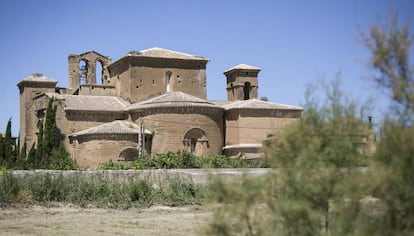Aragon will claim the Prado Museum The Nativity from Sijena if it is proven that it came out of the monastery illegally after the civil war. This was stated by the vice president of Aragon, Mar Vaquero, in statements to the regional press this Wednesday.
The work, a Gothic painting that was part of the main altarpiece of the Cenobium, has been exhibited since 2003 in the Prado. Juan José Nieto, a researcher, historian and expert in the case of Sijena’s paintings by the Oscense City Council, has pointed out the possibility that, after the civil war, this Natividad I illegally came out of the monastery, already declared a National Monument in 1923. Nieto is based on the documentation provided by the National Museum of Art of Catalonia (MNAC) on the paintings of Sijena that it exhibits in one of its rooms, and are subject to a judicial battalion that concluded last May with the Supreme Court Judgment. The Court gave the reason to the Aragon government, dismissed the resources of the Generalitat and the MNAC and ordered that the thirteenth -century Romanesque frescoes return to their point of origin. The Supreme Court argued that the Catalan museum has not accredited any “document-control” that legitimizes that “possession” and that its guard is in “deposit” mode, since “it has not possessed the paintings as an owner, since the paintings were torn.”
The Nativity It was also part of the set of Gothic paintings taken from Sijena, and today is exposed in the meadow. In 2003, the State acquired at an auction in the Alcalá Sala (Madrid) for 90,000 euros, according to an official document that the Pinacoteca shared on social networks. The piece was sold by the San Juan nuns, which is not known precisely is the date of his departure from Sijena.
After the statements of the Vice President of Aragon, from the Prado Museum they point out that “if there are revelations that indicate the illegality at the exit of Sijena’s work, it will proceed according to what the institutions decide”, and insist that the meadow is “contrary to illegality and will be climbed if proven”. In 2023 the Prado Museum prepared a report with the expert Arturo Colorado on the works of his funds whose origin are seizures, and determined that it was 70 pieces. Sijena’s painting was not among them. “The works must be in possession of their legitimate owners and this necessarily opens a study period,” they insist from the museum.
Until now the journey of The Nativity He referred to an article in 1926 of the art historian August Mayer in which he assured that the work was bought by the antiquarian to Nicholson, who was the one who put it on sale in London. In 1944 the collector Arnold Seligmann included the work in the great exhibition of world fame paintings in the rooms of Galleries Ordáz, in Mexico City. After that sale, it appeared in Madrid. The historian Nieto has now explained to the media that “the photographs show that the painting was in 1936 in the monastery chapter room because it is seen next to some walls already scratched by Gudiol, and that, therefore, they must be considered as a plump of war, since they could not be sold because SIJENA was already a national monument”. His statement has been refuted in social networks by Hiteriators Albert Velasco and Merisancho Mejón, former general director of the Cultural Heritage of the Government of Aragon. Mejón has assured that the “table could not be in the chapter room of Sijena in 36; if she had been, she would have burned. The dates of the photos are confusing.”
What you have had to see are photos prior to the fire. There are several, from approx. 1919, as this one published by Ricardo del Arco on that date: pic.twitter.com/T7eQ7ZBxQg
– Mari Menjón (@inde) August 6, 2025
This Wednesday the vice president of Aragon has stressed that the doubts about the date of the departure of Sijena de The Nativity They come from information provided by the technicians, but has pointed out that in the event that it is confirmed, as has happened with the rest of wrapped works in the long process of claims and litigation with the MNAC. “We would proceed in the same way, claiming,” he emphasized.
The Prado piece shows the Sacred Family with the child lying on the ground and is attributed to the Sijena teacher, who resided in the monastery at the dates on which this painting was made, according to a notarial document.

